20 BEST THINGS TO DO IN GYEONGJU [KOREA GUIDE]
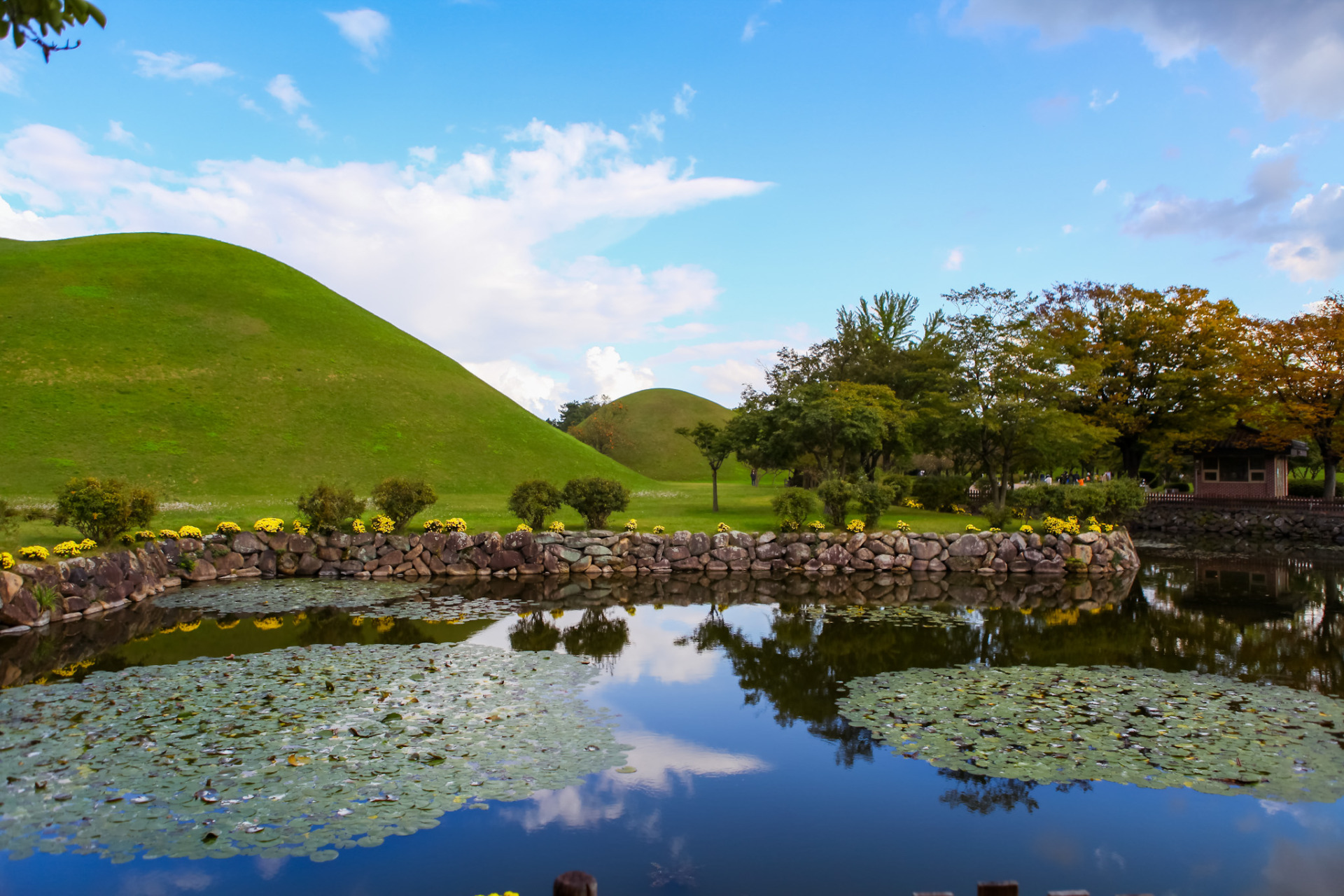
WHAT TO DO IN GYEONGJU? THE BEST FOOD IN GYEONGJU? WHERE TO STAY IN GYEONGJU?
Gyeongju is one of the main cultural sights in South Korea. When traveling to South Korea, visiting Gyeongju is an absolute must
Gyeongju is the former Capital of Kingdom of Silla (Korea)
The city and its surroundings are full of historic sites, temples, and other landmarks to discover.
We recommend staying at the very least 2 days to visit all the main sights (ideally 3 days), although it is possible to visit on a day trip.
Read also: 99 most amazing things to do in South Korea
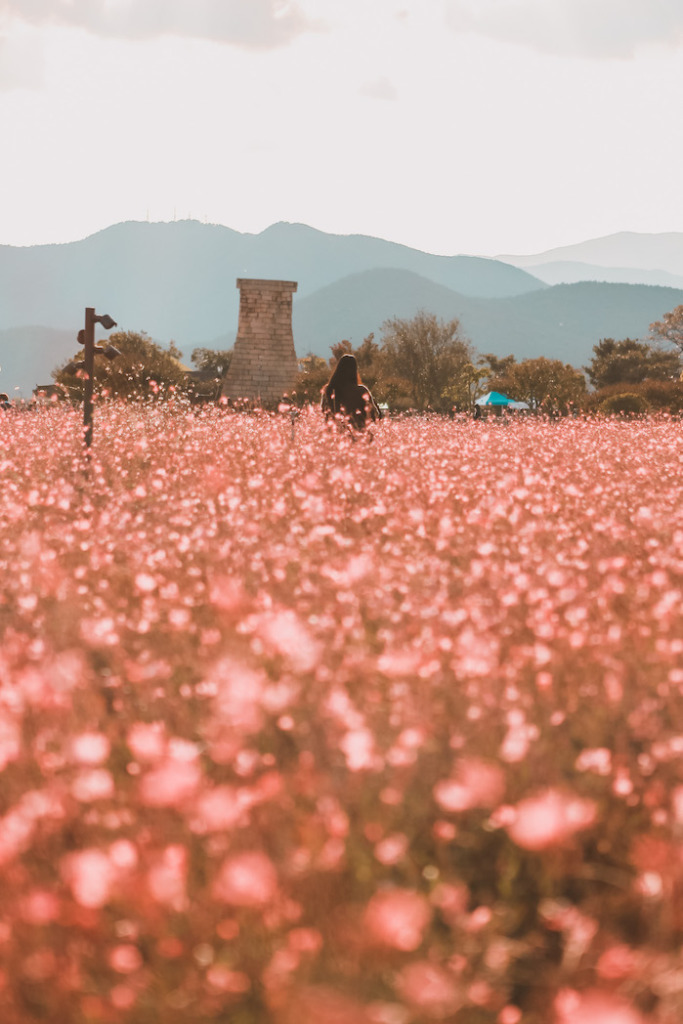

Key Takeaways from a trip to Gyeongju in Korea:
– Known as the “Museum Without Walls,” Gyeongju is rich in historical and cultural sites (more than 30 national treasures)
– Visit Bulguksa Temple, a UNESCO World Heritage site.
– Check out Seokguram Grotto, another UNESCO site
– Visit Cheomseongdae Observatory, one of the oldest observatories in Asia
– Check out the Royal Tombs, a unique thing to see in Gyeongju
– Explore the nearby village of Yangdong, one of the most charming villages in Korea
– And so much more, which we listed in this articles
How to get to Gyeongju:
- The easiest way to get to Gyeongju from Seoul is by train (KTX). It takes about 2 hours
- The best time to visit Gyeongju is spring (April ~ June) and fall (September ~ November)
- Near Gyeongju, you can visit Busan, Uslang or Pohang
Here is a glimpse of what a visit to Gyeongju looks like:
HISTORY OF GYEONGJU, ONCE THE 4TH LARGEST CITY IN THE WORLD
Did you know that a long time ago, Gyeongju was the 4th largest city in the world and the old capital of South Korea?
Indeed, Gyeongju was once the capital of the Silla Kingdom which was founded in 57 BC. At that time, the city knew three different names: Gyerim (the forest of the rooster), Seorabeol (the capital), and Geumseong (the city of gold). In 668, it became the cultural center of Korea following the unification of the peninsula.
In 682, Gyeongju was greatly enriched after the creation of the Gukhak, the national Confucian academy, by King Sinmun. Impressive right?
However, Gyeongju lost its status as the capital of Silla when it was replaced by Koryo. The city was named Gyeongju by King Taejo, founder of Koryo, in 940. It was named the eastern capital from 987 to 1012 before losing its attractiveness.
During its period of decline, the monuments of Gyeongju were destroyed. This was particularly the case with a nine-story pagoda in Hwangnyongsa, demolished by the Mongols in the 13th century, and the Bulguksa temple burnt down during the Japanese invasions.
Today, Gyeongju is listed as a UNESCO World Heritage. You can find more details in their website here.
BEST THINGS TO SEE IN GYEONGJU?
Klook.com1. Start your visit at Daereungwon Park to see the Royal Tombs, one of the main highlights in Gyeongju
Start your day at the Daereungwon Tombs (대릉원경주시 사적공원).
These tombs called tumulus, are the most representative sights of Gyeongju. These small green mountains which spring up everywhere in the city, shelter the remains of the sovereigns and nobles of the kingdom of Silla (57 BC – 935 AD).
There are nearly 150 of them just in the city center: some barely perceptible, others over 20 meters high, and some topped by imposing trees.
The tombs of the Daereungwon complex is one of the best places to admire these Tombs, although, you can see them pretty much everywhere in the city.
Daereungwon is a gorgeous park that allows you to walk around these tombs. Inside the park, you can also admire bamboo groves, pine forests, and stunning ponds. It’s the perfect place to take plenty of great shots!
The 13th ruler of Silla, King Michu, is also buried in Daereungwon. A king whose legendary fame is such that it perhaps explains why his tomb is the only one surrounded by a stone enclosure.
In 1973, excavations brought to light the Cheonmachong tumulus, known as the “celestial horse”. It is the only one that can be visited from the inside, and that allows one to understand how the elite of the kingdom was buried.
Daereungwon Park is undeniably one of the best things to do in Gyeongju!
- Location: here
- Hours: Every day: 9:00am ~ 10:00pm
- Admission: Adults: W3,000; Children 13-18: W2,000; Children 7-12: W1,000
- Website: here
2. Check out Cheomseongdae Observatory, one of the most interesting things to see in Gyeongju
Next, continue your visit by foot to Cheomseongdae Astronomical Observatory (첨성대).
When you exit Daereungwon in the South Gate, cross the road and make a left turn. You will see the observatory right away.
It is said that Cheomseongdae is the oldest astronomical observatory in Asia. At that time, people believed that Heaven was round and Earth was square.
That’s why, Cheomseongdae rests on a square platform, and its structure is cylindrical, thinning upwards. It is nothing like an astronomical observatory as we know it today, obviously.
We actually wondered how people could look at the stars from the inside.
After visiting Cheomseongdae Astronomical Observatory, continue your visit to the rest of the park surrounding the observatory. This is another great thing to see in Gyeongju!
- Location: here
- Opening Hours: 24h
- Admission: Free
3. Gyeongju Pink Muhly, one of the most beautiful things to see in Gyeongju
If you visit during the Autumn, you might be lucky enough to admire a huge field of pink Muhly right next to the Observatory.
This pink grass is a popular sight all around South Korea during Autumn. It makes some of the best Instagram shots. The field next to the Observatory is particularly beautiful.
The rest of the park around Cheomseongdae Astronomical Observatory is equally beautiful. You can also admire the famous silver grass and other nice flowers during Autumn.
We’ve never been to Gyeongju during other seasons, but we can only imagine that during Spring another great season to visit Korea, it must be stunning as well.
- Location: here
- Opening Hours: 24h
- Admission: Free
4. Continue your visit to Gyeongju Gyerim Forest
Continue your way through the forest of Gyerim (경주 계림). Legend has it that it is the birthplace of Kim Al-Ji, the ancestor of the Kim clan. Gyerim Forest is located between Cheomseongdae Observatory and Wolseong Fortress and is accessible by foot.
Legend has it that King Talhae heard a rooster crying from the depths of Sirim Forest. Chancellor Hogong was sent to investigate. When he arrived there, he found a rooster crying under a tree from which hung a golden box. Hogong returned to report to the king, who ordered him to return the golden box to the palace.
The king opened the box and found inside a small child, Kim Alji. The forest, originally named “Sirim” or “Gurim”, came to be known as “Gyerim” (“gye” means rooster). Gyerim’s name also referred to the kingdom of Silla.
Alji became the king’s adopted son, but as the crown passed to King Pasa of the Park family, he never ascended to the throne. A few years later, the Kim clan became the ruling family with the coronation of King Naemul.
Yellow rapeseed flowers bloom along the path connecting Daereungwon with Gyerim and Banwolseong, making the atmosphere of the forest even more magical.
- Location: here
- Opening Hours: 24h
- Admission: Free
5. Woljeonggyo Bridge, one of the best things to see in Gyeongju
After crossing the forest of Gyerim, you will reach another main sight of Gyeongju: Wolseong Palace.
This palace is most famous for its gorgeous bridge crossing the Namcheon River: Woljeonggyo Bridge (월정교). Unfortunately, only ruins remain from the palace, but the bridge remains stunning.
There is a legend about the Woljeonggyo Bridge.
One day when Monk Wonhyo was passing by, he began to sing, saying he wanted to build a pillar to support the sky. King Muyeol then realized that he needed to be married off to a woman of high rank, who would give birth to one of the pillars of the Silla dynasty.
He maneuvered for the monk to be welcomed into the apartments of his own daughter, Princess Yoseok.
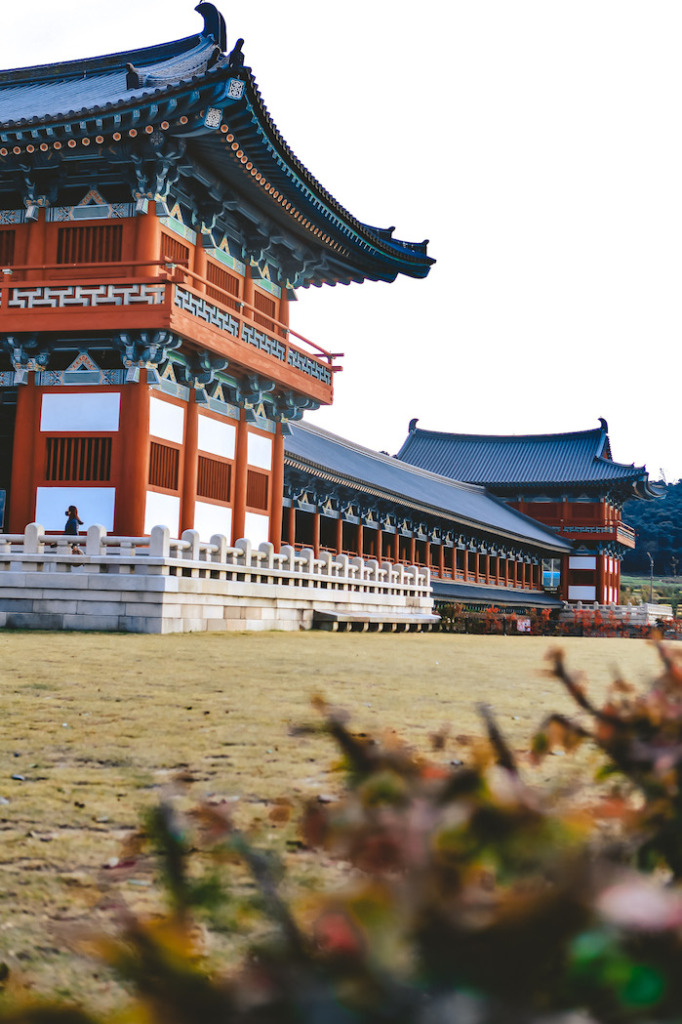
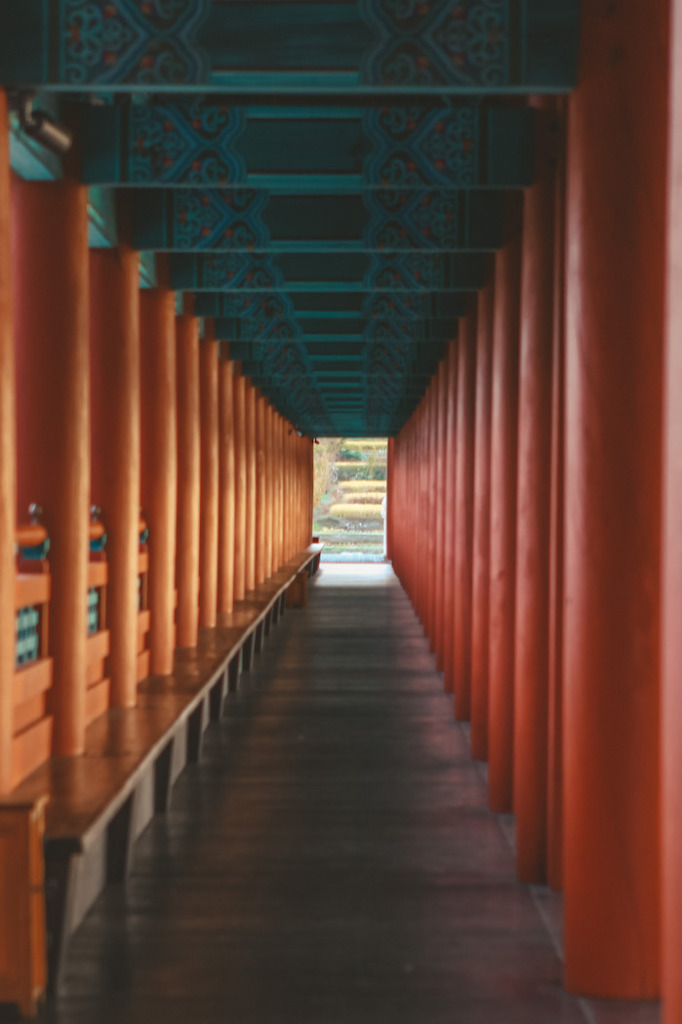
The inevitable happened. A few months later, she gave birth to Seol Chong, who later became famous for creating the Idu writing system, where Chinese characters are used to transcribe Korean.
Woljeonggyo Bridge dates from 760. Perfectly symmetrical, one can only marvel at such engineering work. It is absolutely essential to see it at night when it is illuminated.
- Location: here
- Opening Hours: 24h
- Admission: Free
6. Visit the beautiful Hanok village of Gyochon, the most charming place in Gyeongju
Right beside Woljeonggyo Bridge, you can continue your visit to the traditional Hanok village of Gyochon (경주교촌마을). This village was home to the Choe family, whose long line dates back to the 16th century.
This clan is known to have correctly applied the precepts of the Seonbi scholars.
They have thus succeeded in preserving their wealth while working for the well-being of the local population.
It is possible to visit the Choe Clan House and even taste Gyeongju Gyodong Beopju Liquor (Important Intangible Cultural Property No.86-3).
The village also offers many cultural activities for tourists. There are also cafes and restaurants.
- Location: here
- Opening Hours: 24h
- Admission: Free
For us, we managed to visit all of the above sights within a day, including time for lunch, coffee break, and many stops to take plenty of photos.
If you stay 2 or 3 days in Gyeongju, that leaves you sufficient time to visit other main sights. So don’t rush everything, take your time and enjoy all the sights one by one. Gyeongju is so gorgeous, its beauty must be appreciated.
However, if you are still up for 1 last thing on the same day, then we recommend visiting Donggung Palace & Wolji Pond, which anyway must be visited at night. You could even have dinner first and then head there to enjoy one of the main highlights in Gyeongju.
7. Donggung Palace & Wolji Pond, are the most magical places in Gyeongju at night!
One of the prettiest spots in Gyeongju is Donggung Palace & Wolji Pond (동궁과 월지). It can be visited at any time of the day, but it is at nightfall that the place reveals all its splendor.
The pavilions are then fully illuminated, making it a magical sight. The reflections on the water are captivating, so much so that it is difficult to take your eyes off this harmonious and lovely scenery.
Donggung Palace dates from the late 7th century. It was King Munmu himself, after unifying the kingdom of Silla, who decided on its construction in 679. This palace was used mainly for banquets and festivals.
A few years later, in 674, an artificial pond was added, made up of flowery hills on which many animals could live. It was named Wolji Pond until the Joseon period, before changing its name to “Anapji”.
The palace has long served as a residence for distinguished guests and for festivities before gradually being abandoned. The pond underwent full rehabilitation between 1975 and 1986, and excavations found that it surrounded more than 26 buildings at the time, five of which were to the west. The materials of these five pavilions served as the basis for the reconstruction of the palace.
- Location: here
- Opening Hours: Every day: 9:00am ~ 10:00pm (we highly recommend going there during sunset and waiting until nightfall)
- Admission: Adults: W2,000; Children 13-18: W1,200; Children 7-12: W600
- Website: here
8. Visit Seokguram Grotto, one of the most mysterious things to see in Gyeongju
On your second day in Gyeongju head to Seokguram Cave (석굴암). The cave houses one of the largest Buddha statues in Korea nestled inside a cave.
Visiting the cave is one of the best things to see in Gyeongju. The cave of Seokguram is one of the jewels of South Korea. Do not miss this historic site, also a UNESCO World Heritage Site.
Nestled in Mount Toham, the cave also offers an incredible panorama of Gyeongju.
Whereas all the previous sights we listed in this blog can be visited on foot as they are all located in the center of Gyeongju, Seokguram Cave is further away. If you have a car, then no problem, a 40-minute drive will get you there with parking available in front of the entrance of the cave.
However, if like us, you took the KTX from Seoul, then taking a taxi would be the best option. You can book a taxi for a full day for only 60,000 won. This would save you a lot of time going from 1 place to the others. Check it out here.
Count roughly 1 hour to visit the cave, which includes a 20-minute walk to get there through a nice forest path.
- Location: here
- Opening Hours: Weekdays 09:00-17:30 / Weekends & public holidays 08:00-17:30
- Admission: Individual: Adults 6,000 won / Teenagers 4,000 won / Children 3,000 won
- Website: here
9. Bulguksa Temple, our favorite thing to visit just outside Gyeongju
It is best to combine the visit of Seokguram Cave and Bulguksa Temple (불국사) as both sights are located near one another and both are far from the city center of Gyeongju.
Bulguksa Temple is another amazing highlight of any trip to Gyeongju. Bulguksa Temple was built in AD 571 and is the most important site for the Buddhist community.
The people of Gyeongju accepted Buddhism as a religion in the 6th century. Beautiful Buddhist art and culture are wonderfully displayed in the magnificent Bulguksa temple.
The intricate interior design and perfection of the temple make it one of the most visited cultural heritage sites in the Gyeongju.
Bulguksa temple is of great beauty. Protected by a relatively dense forest, punctuated by the sound of Buddhist litanies, it conceals an incalculable number of national treasures, representative of the Buddhist aesthetic of the time of Silla.
Count at least 2 hours to visit the entire temple. There is also a very cute tea house inside the temple, perfect if you need a small break.
For us, it was one of our favorite temples we visited in Korea, besides Naksan Temple in Yangyang, Haedong Yonggungsa in Busan, Jingwansa in Seoul, and Jeondeungsa in Ganghwado near Incheon.
- Location: here
- Opening Hours: Weekdays 09:00-17:00 / Weekends and public holidays 08:00-17:00
- Admission: Adults 6,000 won / Teenagers 4,000 won / Children 3,000 won / Preschoolers 2,000 won
- Website: here
READ: FULL GUIDE FOR VISITING BULGUKSA TEMPLE
10. Gyeongju Market
After finishing your visit to Bulguksa, walk across the street. You will find many restaurants and cafes built in Hanok style. There is also a market to get some souvenirs. We stopped there to get an afternoon snack and coffee. There are many nice cafes around this area!
Visiting Seokguram Cave and Bulguksa Temple will take you almost 1 full day. After you finish your visit head back to Gyeongju City Center.
We recommend walking around the city and finding a nice place for dinner (more on dinner recommendations below).
Website: here
11. Wander around Gyeongju’s main shopping avenue: Hwangnidangil
Besides all the cultural sights, Gyeongju is a charming city and a few streets are really worth visiting. Filled with Hanoks, Restaurants, bars and coffee shops, it is very pleasant to walk around the city.
Hwangnidangil is one of the main tourist streets. Walk there at any time of the day and you will find something to do or to eat. Behind Hwangnidangil, there is a parallel backstreet filled with very cute Hanoks.
We actually liked this street even more. One of the restaurants specifically caught our attention (see photo above), called Oncheonjip. Check out their Instagram here and location here.
12. Gyeongju Tower in Gyeongju World Expo Park
On your last day in Gyeongju (for a 3 day trip) head to Gyeongju World Cultures Expo (경주세계문화엑스포공원).
The park is an innovative cultural amusement park providing a place for cultural experience and relaxation. The main attractions are: 3D Animation World, Silla Culture History Pavilion, World Cinematography Gallery, World Fossil Museum, and Fun Challenge World.
You can learn about the rich cultural heritage of the Silla Dynasty (-57 BC to 935), historical relics from the four ancient world civilizations and various folk tales from around the world.
Various exhibitions, traditional culture programs, and seasonal events provide visitors with a relaxed learning experience.
However, the main reason we wanted to visit this place, was to see the amazing Gyeongju Tower.
This tower is a remarkable construction that can be seen from afar. This structure is actually the landmark of Gyeongju Cultural and World Expo Park. This tower reproduced the shape of the nine-story wooden pagoda of Hwangnyongsa Temple. You can take a lift to the top of the tower for a beautiful 360-degree panorama of Gyeongju.
- Getting There: it takes about 20min by taxi, or 45min by bus from the city center of Gyeongju. Count at least 1.5 hours to visit the entire Park.
- Admission: Adults W8,000; Children W7,000
- Website: here
- Location: here
- Opening Hours: 10:00am ~ 10:00pm
13. Jungdo Tower, the most beautiful tower in Gyeongju
After your visit to Gyeongju World Cultures Expo, head to Jungdo Tower which is just a few minutes walk. This stunning and very impressive Pagoda is the reconstruction of a 7th-century wooden pagoda which was located at Hwangnyongsa Temple.
However, please note that it is not possible to visit the interior of the Pagoda. It is actually reserved for corporate retreats, featuring meditation rooms, accommodations, and other facilities.
Nevertheless, it is still a beautiful place to see especially for a photo across the river passing right in front of the pagoda.
14. Cycle at Bomun Lake famous for cherry blossoms
Bomun Tourist Complex is an area around Bomun Lake, 10 km east of downtown Gyeongju. There, you will find huge luxury resorts, condominiums, golf courses, amusement parks, walking trails, etc.
There are many cherry trees in Gyeongju and especially in the Bomun area. Many tourists visit this place for the cherry blossoms. Bomun Pavilion is one of the most popular sights in this area.
As the lake is pretty big, we recommend renting a bicycle to explore it. We saw many shops renting out bicycles. As for us, we decided to skip that part of Gyeongju since we only stayed 3 days and we did not visit during the cherry blossoms season.
Instead, we headed to Yangdong village, which turned out to be one of our favorite things to see in Gyeongju.
15. Visit the gorgeous village of Yangdong near Gyeongju
Yangdong (양동마을) is a really cute and traditional village with houses built 100 to 500 years ago. Yangdong Folk Village is a World Heritage Site. The houses have been well preserved and many are still inhabited…
When you enter the village, take a map at the entrance, as there are quite a lot of hidden streets behind some hills, which are absolutely must-sees.
Don’t just stay on the main road, venture yourself deep inside the village to see the most beautiful areas.
We loved Yangdong so much, that we spent quite a lot of time exploring and admiring the village just thinking about what it was like to live here 500 years ago. Yangdong was one of our main highlights during our trip to Gyeongju.
We would even rank this place as the nicest village in Korea!
They have a few very traditional restaurants. We opted for a place called Uhyang Daok. The owners, an old couple, were so so nice to us. They spoke a little English and were so interested in our stories and where we came from.
They served us a delicious meal, in fact, one of the best meals we had in Gyeongju. Here is the location.
To get there count 40min by car from Gyeongju city center and 1 hour by bus.
- Admission: Adults 4,000 won / Teenagers 2,000 won / Children 1,500 won
- Website: here
- Location: here
- Opening Hours: 09:00 – 19:00
READ: FULL GUIDE TO YANGDONG VILLAGE NEAR GYEONGJU
16. TASTE THE LOCAL DELICACIES: GYEONGJUPPANG AND CHALBORIPPANG
Literally “Gyeongju bread”, Gyeongjuppang (경주빵) is a brioche bun filled with red bean paste, with a chrysanthemum drawn on top.
With a recipe dating back to the days of the kingdom of Silla, we can say that the reputation of this delicacy keeps all its promises. Hot out of the oven, they are delicious! You will find many bakeries offering Gyeongjuppang all around Gyeongju.
As for Chalborippang (찰보리 빵 ), this delicacy looks a bit like a pancake. It is also filled with red beans. We actually like Chalborippang more than Gyeongjuppang.
17. Try the local traditional liquor: BEOPJU
What better way to take advantage of this trip than to test a different alcohol? Try beopju, a liqueur typically native to Gyeongju, made from sticky rice. Be careful though: it could be quite strong. Beopju is served in most local restaurants in Gyeongju.
18. Eat like a King in a Hanjeoksik restaurant in Gyeongju

Gyeongju is the city of kings and great Korean food. What better opportunity to enjoy traditional Korean restaurants that offer the famous hanjeongsik, the royal menu?
Do not hesitate to venture into one of these restaurants, you won’t regret it. You will experience a royal dinner that will not leave you hungry.
Between the multiple banchan, and the different main dishes (meat, fish, soups, etc.) you will be delighted!
We highly recommend a place called Dosol Maeul, located in the center of Gyeongju (here). However, be sure to come early if you go for dinner, as this place is very popular amongst Koreans.
We absolutely loved the food in Gyeongju. Similar to Jeonju (more info here), food in this part of Korea is absolutely amazing.
19. Step Back in Time at Gyeongju National Museum
If you still have time left in Gyeongju, we recommend a visit to Gyeongju National Museum.
If you want to know more about the history of Gyeongju, which is really fascinating, then this Museum is a must.
This renowned museum houses an impressive collection of artifacts and relics from the Silla Dynasty, which ruled the region for almost a millennium.
Marvel at the golden crowns, delicate jewelry, and ancient pottery that offer glimpses into the lives of the Silla people. The museum’s well-curated exhibits provide a comprehensive overview of Gyeongju’s rich historical heritage.
20. Hike at the Gyeongju National Park
If you’re a nature lover and enjoy outdoor activities, Gyeongju National Park is a paradise for hikers.
With its picturesque landscapes and well-maintained trails, the park offers breathtaking views and a chance to connect with nature.
Lace up your hiking boots and embark on the challenging but rewarding hike up Namsan Mountain.
As you ascend, you’ll be greeted by lush forests, serene temples, and stunning panoramic vistas of the city below.
Don’t miss the iconic rock-carved Buddha statues nestled along the trail.
Gyeongju National Park provides an opportunity to combine cultural exploration with invigorating outdoor adventure, creating unforgettable memories for hikers of all skill levels.
WHERE TO STAY IN GYEONGJU?
If you visit Gyeongju we recommend staying in a Hanok to experience this place fully. Most hotels are around the city center, which is the best place to stay if you visit Gyeongju.
Hanok 1st Street

Hanok 1st Street is a beautiful Hanok Hotel located near the main sights in Gyeongju. This place is absolutely stunning and would make your trip to Gyeongju complete. If you travel to Korea, experiencing staying in a Hanok is a must.
Gyeongju Wadamjung Hanok Pension

Gyeongju Wadamjung Hanok Pension is located close to Gyeongju Gyochon Traditional Village. In other words, one of the best places to stay in Gyeongju.
On top of the great location, this Hanok is beautiful and the garden at the center makes it a magical place to stay. The other good thing about Gyeongju Wadamjung Hanok Pension is that breakfast is included in the price.
This place is often fully booked, however, if it’s still available during your stay, do not hesitate, to book it right away.
Hwangnamkwan Hanok Guesthouse
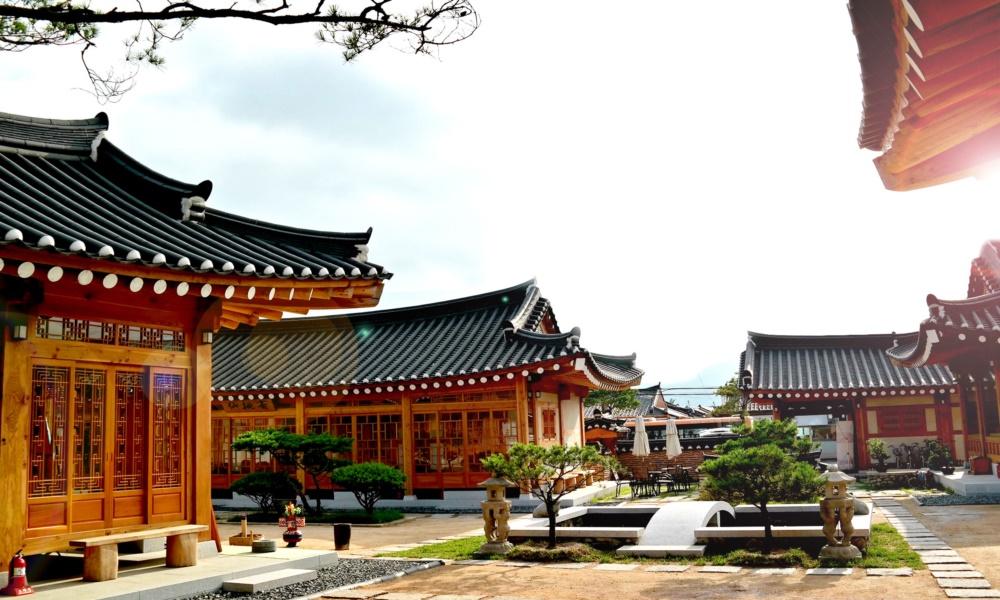
Hwangnamkwan Hanok Guesthouse is located right off the main tourist street of Gyeongju. If you stay here, it will be easy to walk around the city and find good restaurants for dinner.
Therefore, we also highly recommend a stay at Hwangnamkwan Hanok Guesthouse.
HOW TO GET TO GYEONGJU?
There are several options if you plan to travel from Seoul.
Train (KTX)
KTX is the fastest way to get from Seoul Station to Singyeongju Station. It would take about 2 hours. If you are planning to visit a few cities in South Korea like Busan, Jeonju, and Gyeongju, there is special discount pass which is only available to international tourists or foreign residents.
These special passes allow unlimited travel on trains managed by KORAIL for a specified period. BUY YOUR PASS HERE.
Express bus
The cheapest way to get to Gyeongju is the bus from Seoul Express Bus Station in Seocho-gu to Gyeongju Express Bus Station. The approximate time to travel is 3 hours and 30 minutes.
You can also book a full-day guided tour by bus. MORE INFORMATION HERE
By car
If you plan to visit Gyeongju by car, it wouldn’t be a bad idea, as you will save some money traveling by taxi to Bulguksa Temple, or Yangdong village. However, without traffic count 4h to get there.
If you are traveling from Busan, the same options are available, either KTX or Express Bus (book here). Both are very convenient as Busan is relatively close to Gyeongju. You can also opt for a private car if you are a small group (up to 8 people). You can book a private tour here.
BEST TIME TO VISIT GYEONGJU?
Gyeongju being a city close to the sea, the weather remains pleasant throughout the year. Generally, the best time of year to visit Gyeongju is spring (April ~ June) and fall (September ~ November).
There is a good amount of rainfall most of the year while the climate remains warm.
By the way, the photo above was taken at the top of Yangdong village. What a view it was!
OTHER THINGS TO DO NEAR GYEONGJU?
1. Pohang
The main tourist attraction in Pohang is undoubtedly the giant sculpture of the hand rising from the waters at Homigot Square, famous for its sunrises. However, if you want to discover the heart of the city, we recommend that you visit the Pohang Canal.
This canal is the result of restoration work on an ancient watercourse that connected the Hyeongsangang River to the Dongbin Port Area.
2. Ulsan
Ulsan is both Korea’s main industrial city and a port city. The major ports are Ulsan Port, Onsan Port and Bangeojin Port. As such, it is considered the hub of trade and exchange of goods to East Asia.
The city’s tourist assets are also increasingly recognized. The city is appreciated by visitors for its picturesque landscape formed by the East Sea and its natural environment.
3. Busan
Busan (부산광역시) is the second largest city in South Korea, after Seoul. It is located at the southern end of the Korean Peninsula. Previously, Busan was referred to as Pusan. This spelling is still sometimes found in South Korea.
Busan’s port is ranked among the 10 largest commercial ports in the world! Very impressive.
There are several landmarks to visit in Busan which are absolutely stunning. Busan even has the most beautiful temple in South Korea! Excited? Oh yes, you should be.
READ: 30 AWESOME THINGS TO VISIT IN BUSAN
FINAL THOUGHTS – IS GYEONGJU WORTH A VISIT?
After living 3 years in Korea, we can absolutely say that Gyeongju is one of our favorite places to visit in Korea. Everywhere you go in the city, it’s so pretty. You can sense all the history and cultural richness of South Korea in Gyeongju.
Besides, it was the 4th largest city in the World hundreds of years ago. How impressive is that!
For people who like to know the history of the world and the stories of people from the past, Gyeongju is the place to visit. It’s so beautiful that it was once a popular honeymoon destination for locals.
If you are traveling to Korea, Gyeongju is practically a must-see. It would be a pity to skip it…
We lived in Korea for 3 years and wrote many posts about things to do in this country. You can check them all here.
READ ALSO
- YANGDONG, the most charming village near Gyeongju
- BULGUKSA temple near Gyeongju
- BUSAN, the second largest in Korea
- GANGNEUNG and the East Coast
- SOUTH KOREA: 99 must-see in South Korea
- HAEDONG YONGGUNGSA, the most beautiful temple in Korea
- TAEAN: amazing national park on the west coast of Korea
- JEJU: All you need to know before you go to Jeju
- JEONJU Hanok Village
- NAMSANGOL Hanok Village in Seoul




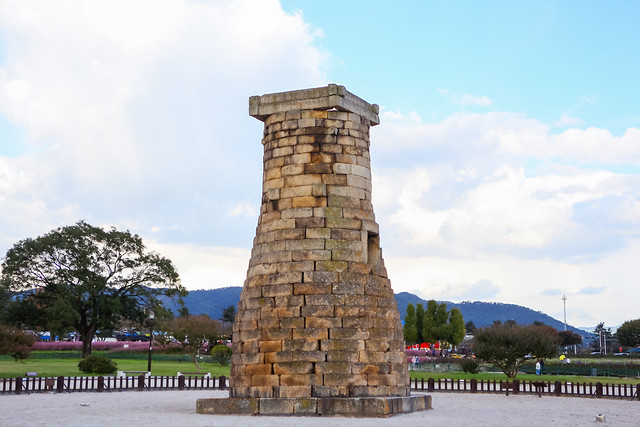














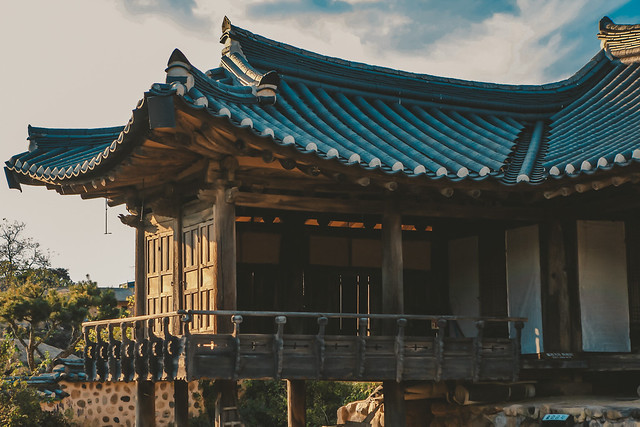












![20 AMAZING SURF SPOTS IN ASIA [ULTIMATE GUIDE]](https://afuncouple.com/wp-content/uploads/2023/10/Best-surf-spots-in-Asia_Cover-768x512.webp)
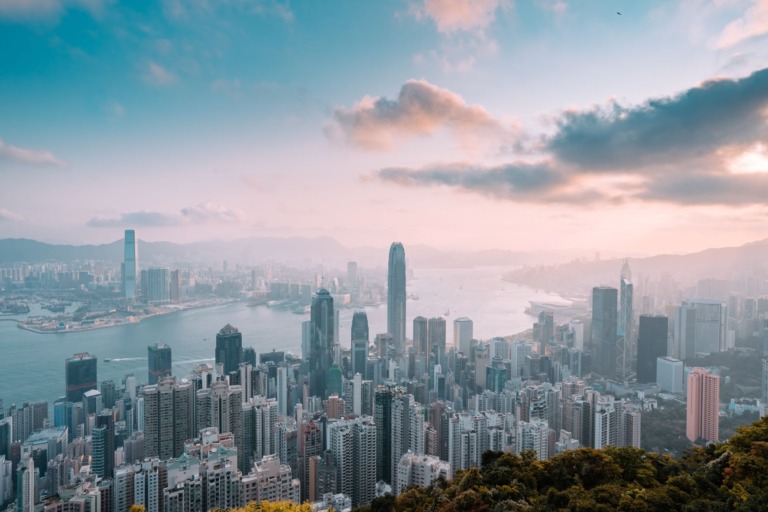

![GUIDE TO THE NINE ARCH BRIDGE IN ELLA [SRI LANKA]](https://afuncouple.com/wp-content/uploads/2022/09/Nine-Arches-Bridge-3-768x512.jpg)
![20 IDEAS FOR A DATE IN SEOUL [KOREA]](https://afuncouple.com/wp-content/uploads/2020/03/IMG_0352-e1691504436666-768x493.jpg)
![10 BEST BEACH CLUBS AROUND CANGGU & SEMINYAK [BALI]](https://afuncouple.com/wp-content/uploads/2023/07/Best-things-to-do-in-Seminyak-5-768x432.webp)